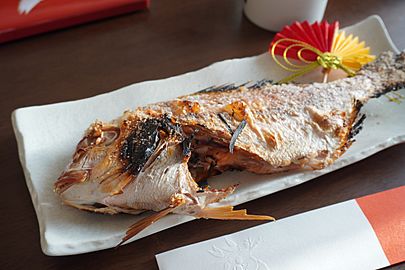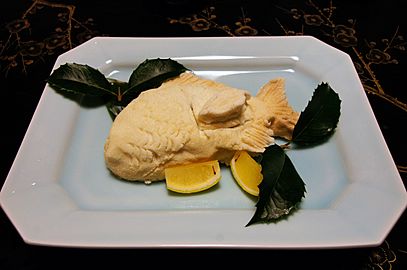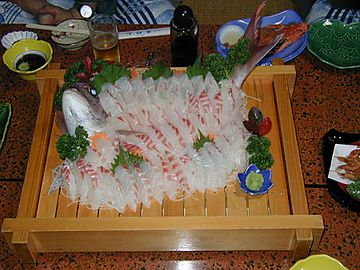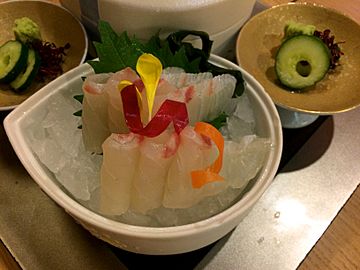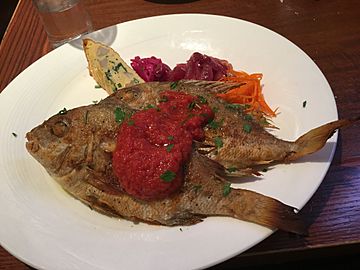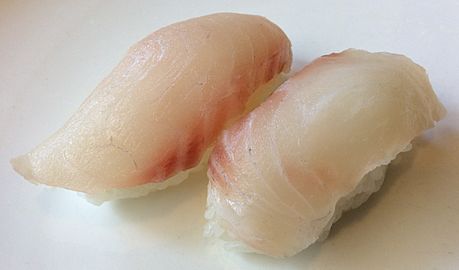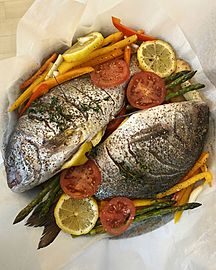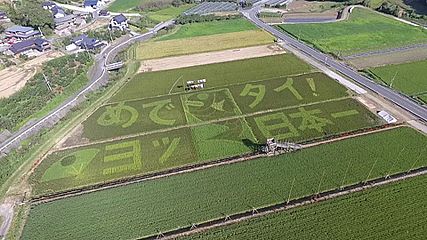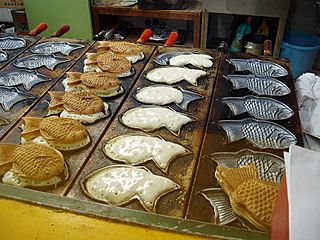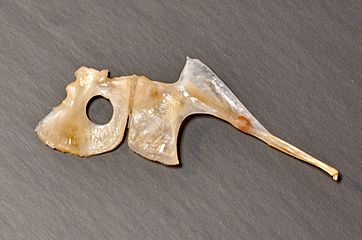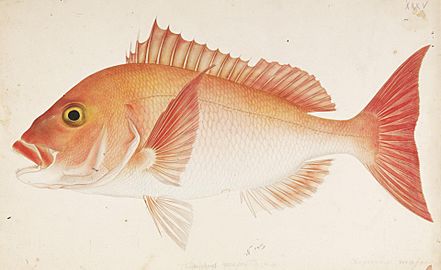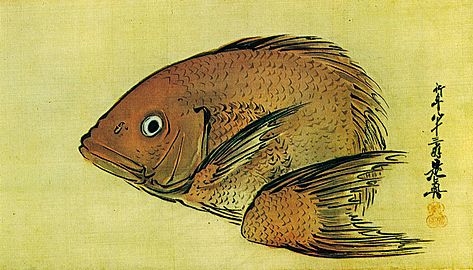Red seabream facts for kids
Quick facts for kids Red seabream |
|
|---|---|
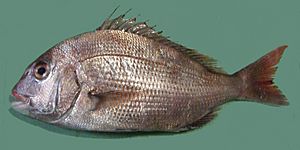 |
|
| Scientific classification | |
| Synonyms | |
|
The red seabream (also known as Pagrus major) is a special fish from the Sparidae family. In Japan, it's called madai. This fish is very important for food and culture in Japan, and people also enjoy eating it in Korea and Taiwan.
Contents
Where the Red Seabream Lives

The red seabream lives in the ocean, mostly in the Northwest Pacific. You can find it from the northeastern part of the South China Sea all the way up to Japan.
Adult red seabream usually live near the bottom of coral reefs. They like depths of about 30 to 200 meters (about 100 to 650 feet). They often live alone. Younger fish, called juveniles, prefer to live in shallower waters.
What the Red Seabream Looks Like
Red seabream can grow quite large. Some can be up to 120 centimeters (about 4 feet) long, but they are usually smaller. Their scales are a pretty pinkish-red to purplish-brown color. They also have small blue spots all over their body.
When they are young, red seabream have five stripes on their bodies. These stripes disappear as they grow older and become adult fish.
Life Cycle of the Red Seabream
Red seabream lay their eggs between February and August. During this time, they swim from deeper waters to shallower areas. The eggs and young fish (juveniles) float freely in the ocean. Their parents do not protect them, which means they can easily become food for bigger fish.
Young red seabream have a special ability. They know which habitats are best for them. This helps them choose the right place to live as they grow. This special skill is only seen in young fish up to about 30 days old. Adult fish do not show this kind of habitat preference.
Both young and adult red seabream eat small ocean creatures. They enjoy shrimp and crabs, as well as smaller fish and sea urchins.
On average, a red seabream can live for a long time, usually between 20 and 40 years!
Red Seabream as Food
In Japan, Pagrus major is known as madai (真鯛), which means "true sea bream," or simply tai (鯛), meaning "sea bream." People love its rich, savory flavor, called umami. It is seen as a luxury food. It is often served at special celebrations like weddings and during Japanese New Year.
The red seabream is also the most commonly eaten fish in Taiwan. In Korea, the fish is called domi (도미) or chamdom (참돔). It is quite popular there as well.
You can cook red seabream in many ways. It can be broiled, grilled, or baked. Many people also enjoy eating it raw, like in sashimi.
Red Seabream in Culture
The red seabream is very important in Japanese culture. It is linked to good luck and plenty. People eat it on special days. Its red scales are thought to bring good fortune and keep away bad spirits.
Important people, like politicians or sumo wrestlers, are often photographed holding a red seabream after they win something. Ebisu, the god of luck and fishermen, is often shown holding a red seabream.
Because it is so special, the red seabream is sometimes called "The King of Hundred Fishes" (百魚の王) in Japan. "Hundred" here means all other fishes.
Several Japanese idioms also talk about the red seabream as something valuable:
- Ebi de tai o tsuru (海老で鯛を釣る): This means "To fish a sea bream using a shrimp as bait." It's like saying you get a big reward with only a small effort.
- Kusatte mo tai (腐っても鯛): This means "Even if it's rotten, it's still sea bream." It shows that something of high quality keeps its value, even if it's not perfect anymore.
- Tai no o yori iwashi no atama (鯛の尾より鰯の頭): This means "Better a sardine's head than a sea bream's tail." It suggests it's better to be the leader of a small group than just a follower in a big one.
There's also a good luck charm called tai no tai (鯛の鯛). This means "bream within bream." It's made from certain bones (scapula and coracoid) of a fish. These bones look like a tiny red seabream! People find these bones after eating the fish. They believe it's a "second bream" inside the first one. While often linked to red seabreams, these bones can come from any fish.
Taiyaki is a popular Japanese cake. It is filled with sweet azuki bean paste. It is famously made in the shape of a red seabream (tai). The person who invented it wanted street food to feel fancy.
-
Tambo art depicting a red seabream in a rice paddy in Fukuoka
-
Taiyaki cakes being made in the shape of red seabream (tai)
Red Seabream in Art
The red seabream has been a popular subject in paintings for a long time. Its unique shape has also been used in various crafts.
-
Painting by Shibata Zeshin (1807-1891)
See also
 In Spanish: Pagrus major para niños
In Spanish: Pagrus major para niños


